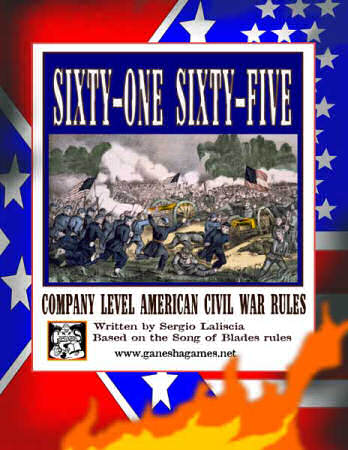|
|
|||||||||||||||||||||||||||||||||||
 |
|
The Rules Directory only works if you help. Write a review. Get the review template here. |
|
TITLE: Sixty-One Sixty-Five American Civil War Company Level Miniature Rules (2010) AUTHOR: Sergio Laliscia PUBLISHER: Ganesha Games (www.ganeshagames.net) PUBLICATION DATE: 2010 WEB SITE/SUPPORT FORUM: Song of Blades Yahoo! Group (rules questions and freebies) PRICE (with date): $8 PDF, $15 printed REVIEWED BY: Andrea Sfiligoi (publisher) PERIOD COVERED: AMERICAN Civil War , company level engagements THE BOOK: Saddle-stitch 8.5” x 11” booklet, 34 pages. It has a color cover with a B&W interior. SCOPE: The game is aimed at playing a full Company on a 1:1 scale; one figure represents one man. ARMY SIZE: The player controls units (Squads) of 4-8 men (or pairs of skirmishers); about 30 to 98 infantry figures per player are needed. BASE UNIT: The base unit is a Squad composed of 4 to 8 infantry; each squad may have a pair of skirmisher attached. Each player will have 3-4 officers. GAME SCALES: The game can be played in any scale. Two sets of measuring sticks, one for “small” scales (15mm or smaller) and one for “larger scales” (20mm or larger) are provided. The sticks, labeled Short, Medium or Long are used to calculate all ranges and moves. The game, like all Ganesha Games products, does NOT use inches or millimeters or other units of measurements-- all is done via the sticks. Turn duration is not stated but represents a variable amount of time from a few seconds to a minute or so. Recommended table size is 3' x 4' at minimum, with larger games being possible on a 6' x 4'. 1 figure is one man. A typical game with a full Company takes around two hours to play. BASING SIZES: Any single based figures will do; the use of movement trays able to hold up to 8 figures each is recommended to speed up play. TURN SEQUENCE: The game uses a modified IGOUGO turn system; squads dice for activation and can be activated on 1, 2 or 3 dice. One action can be performed per every die passed; but if two or 3 dice fail, the turn ends and play passes to the opponent. The player can activate units, skirmishers, leaders etc. separately and in whatever order he sees fit. GAME MECHANICS: The game is d6 based. Each squad has two scores, Quality and Combat. Quality is the number to be rolled on d6 to activate the squad; Combat is the number added to a d6 roll to perform combat. Combat is modified by weapon, range, cover, and numbers. The total of the attacker is compared to the total of the defender (both players take an active part in combat) and the difference is a gauge of losses. A single die is rolled by each player to resolve combat. Skirmishers' fire is effective against other skirmishers; against squads, it generally does not cause many losses, but can cause confusion, forcing the confused squad to fight at reduced efficiency (or even to test morale) and forcing the squad's corporals to keep their men in line. Formations have some bearing in play as columns move faster but fight less efficiently than lines. Morale is rolled by the Squad whenever more than one loss is sustained in a firefight or melee. Broken squads run to the table edge and stragglers can later be rallied by the captain, forming new units. When one third of the men in one force are casualties, the game ends and that force loses the game. The one third casualty break point is for historical games. Players may agree to play a longer game up to 50% of casualties. A card based initiative system is also offered for multiplayer games. Two “conversion” pages are also offered to play small skirmishes (5-20 men per player) using our Song of Drums and Shakos Napoleonic skirmish rules. ARMY LISTS/SCENARIOS: There are army lists for the two armies for the three periods of the war. There are three scenarios, one with only infantry, one with artillery and another with cavalry; the standard rules can be used for pickup games. Scenarios and rules detail how terrain is arranged and troops deployed. There is no point system: the players are supposed to play with roughly equal forces or as instructed by the scenarios. The use of artillery and cavalry is optional and must be agreed upon by the players. REVIEWER’S COMMENTS: None PLAYER’S COMMENTS: The game has been playtested and used as a participation game at several conventions; in all cases the players had no problem understanding the rules and using their forces in an efficient way after two-three turns. Convention games used less than 50 figures per player but we also ran Napoleonic variants with over 100 figures per player. The rules are very simple and focus on keeping a chain of command and coordinating skirmishers and squads; first you soften the enemy by harassing his forces with your skirmishers, then launch in a decisive attack with your main forces. Fans of hyper-detailed rules and page after page of modifiers will probably not like this game. The game uses only a marker for a Squad with discharged weapons. The status of the unit is shown removing figures (casualties) or turning them with their back to the enemy (shaken soldiers). |
|
[Home] [15mm World] [Reviews Home] [How To] [Beginners Guide] [Gamer's World] [Spanner & The Yank] [Points of View] [The Annex] [Links] [Say Howdy] [Corporate Schill] [Rules Directory] |
 |
